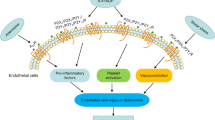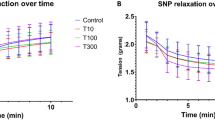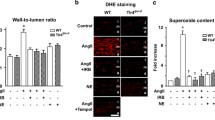Abstract
There is a growing body of evidence pointing to the role of purinergic signaling in the development and progression of various conditions that have inflammation as a common pathogenetic denominator. The aim of the present study was to assess the involvement of P2Y11 purinergic receptors in the regulation of vascular function in aortic segments obtained using an experimental model of acute inflammation, the lipopolysaccharide (LPS, 8 mg/kg, i.p)-treated rats. Twelve hours after LPS administration, thoracic aortas were isolated and used for studies of vascular reactivity in the organ bath and for the measurement of reactive oxygen species (ROS) generation, respectively. LPS treatment significantly increased contractility to phenylephrine and attenuated the endothelium-dependent relaxation of the vascular segments in response to acetylcholine; an increased production of hydrogen peroxide (H2O2) was also recorded. The P2Y11 activator, NF546, decreased the LPS-induced aortic H2O2 release and partially normalized the vasomotor function, namely reduced contractility and improved relaxation. The effect was abolished by co-treatment with the P2Y11 inhibitor, NF340, and also after endothelium denudation. Importantly, NF546 did not elicit an antioxidant effect by acting as a H2O2 scavenger, suggesting that the beneficial outcome of this treatment on the vasculature is the consequence of P2Y11 stimulation. In conclusion, purinergic P2Y11 receptors stimulation improves vascular function and mitigates oxidative stress in the setting of acute systemic inflammation, revealing salutary effects and therapeutic potential in pathologies associated with endothelial dysfunction.





Similar content being viewed by others
References
Kaczorowski DJ, Tsung A, Billiar TR (2009) Innate immune mechanisms in ischemia/reperfusion. Front Biosci (Elite Ed) 1:91–98
Ralevic V, Dunn WR (2015) Purinergic transmission in blood vessels. Auton Neurosci 191:48–66. doi:10.1016/j.autneu.2015.04.007
Communi D, Govaerts C, Parmentier M, Boeynaems JM (1997) Cloning of a human purinergic P2Y receptor coupled to phospholipase C and adenylyl cyclase. J Biol Chem 272:31969–31973
Balogh J, Wihlborg AK, Isackson H, Joshi BV, Jacobson KA, Arner A, Erlinge D (2005) Phospholipase C and cAMP-dependent positive inotropic effects of ATP in mouse cardiomyocytes via P2Y11-like receptors. J Mol Cell Cardiol 39:223–230. doi:10.1016/j.yjmcc.2005.03.007
Amisten S, Melander O, Wihlborg AK, Berglund G, Erlinge D (2007) Increased risk of acute myocardial infarction and elevated levels of C-reactive protein in carriers of the Thr-87 variant of the ATP receptor P2Y11. Eur Heart J 28:13–18. doi:10.1093/eurheartj/ehl410
Erlinge D, Burnstock G (2008) P2 receptors in cardiovascular regulation and disease. Purinergic Signal 4:1–20. doi:10.1007/s11302-007-9078-7
Chadet S, Ivanes F, Benoist L, Salmon-Gandonniere C, Guibon R, Velge-Roussel F, Babuty D, Baron C, Roger S, Angoulvant D (2015) Hypoxia/reoxygenation inhibits P2Y11 receptor expression and Its immunosuppressive activity in human dendritic cells. J Immunol 195:651–660. doi:10.4049/jimmunol.1500197
Urban D, Hartel FV, Gadiraju K, Gunduz D, Aslam M, Piper HM, Noll T (2012) Extracellular ATP attenuates ischemia-induced caspase-3 cleavage in human endothelial cells. Biochem Biophys Res Commun 425:230–236. doi:10.1016/j.bbrc.2012.07.073
Wang L, Karlsson L, Moses S, Hultgardh-Nilsson A, Andersson M, Borna C, Gudbjartsson T, Jern S, Erlinge D (2002) P2 receptor expression profiles in human vascular smooth muscle and endothelial cells. J Cardiovasc Pharmacol 40:841–853
Sturza A, Leisegang MS, Babelova A, Schroder K, Benkhoff S, Loot AE, Fleming I, Schulz R, Muntean DM, Brandes RP (2013) Monoamine oxidases are mediators of endothelial dysfunction in the mouse aorta. Hypertension 62:140–146. doi:10.1161/HYPERTENSIONAHA.113.01314
Meis S, Hamacher A, Hongwiset D, Marzian C, Wiese M, Eckstein N, Royer HD, Communi D, Boeynaems JM, Hausmann R, Schmalzing G, Kassack MU (2010) NF546 [4,4′-(carbonylbis(imino-3,1-phenylene-carbonylimino-3,1-(4-methyl-phenylene)-car bonylimino))-bis(1,3-xylene-alpha,alpha’-diphosphonic acid) tetrasodium salt] is a non-nucleotide P2Y11 agonist and stimulates release of interleukin-8 from human monocyte-derived dendritic cells. J Pharmacol Exp Ther 332:238–247. doi:10.1124/jpet.109.157750
Komulainen A (2013) Altered purinergic signalling in endothelial cells represents a novel mechanism of pulmonary vascular disease
Frimmel K, Vlkovicova J, Sotnikova R, Navarova J, Bernatova I, Okruhlicova L (2014) The effect of omega-3 fatty acids on expression of connexin-40 in Wistar rat aorta after lipopolysaccharide administration. J Physiol Pharmacol 65:83–94
Griffiths MJ, Curzen NP, Mitchell JA, Evans TW (1997) In vivo treatment with endotoxin increases rat pulmonary vascular contractility despite NOS induction. Am J Respir Crit Care Med 156:654–658. doi:10.1164/ajrccm.156.2.9606110
Burnstock G (2009) Purinergic regulation of vascular tone and remodelling. Auton Autacoid Pharmacol 29:63–72. doi:10.1111/j.1474-8673.2009.00435.x
Burnstock G, Ralevic V (2014) Purinergic signaling and blood vessels in health and disease. Pharmacol Rev 66:102–192. doi:10.1124/pr.113.008029
Hechler B, Cattaneo M, Gachet C (2005) The P2 receptors in platelet function. Semin Thromb Hemost 31:150–161. doi:10.1055/s-2005-869520
Yamamoto K and Ando J (2004) Shear-stress sensing via P2 purinoceptors in vascular endothelial cells. Nihon Yakurigaku Zasshi 124:319–328.
Boncoeur E, Tardif V, Tessier MC, Morneau F, Lavoie J, Gendreau-Berthiaume E, Grygorczyk R, Dagenais A, Berthiaume Y (2010) Modulation of epithelial sodium channel activity by lipopolysaccharide in alveolar type II cells: involvement of purinergic signaling. Am J Physiol Lung Cell Mol Physiol 298:L417–L426. doi:10.1152/ajplung.00170.2009
Liverani E, Rico MC, Yaratha L, Tsygankov AY, Kilpatrick LE, Kunapuli SP (2014) LPS-induced systemic inflammation is more severe in P2Y12 null mice. J Leukoc Biol 95:313–323. doi:10.1189/jlb.1012518
Zemskov E, Lucas R, Verin AD, Umapathy NS (2011) P2Y receptors as regulators of lung endothelial barrier integrity. J Cardiovasc Dis Res 2:14–22. doi:10.4103/0975-3583.78582
Macarthur H, Wilken GH, Westfall TC, Kolo LL (2011) Neuronal and non-neuronal modulation of sympathetic neurovascular transmission. Acta Physiol (Oxf) 203:37–45. doi:10.1111/j.1748-1716.2010.02242.x
Ralevic V (2009) Purines as neurotransmitters and neuromodulators in blood vessels. Curr Vasc Pharmacol 7:3–14
Marrelli SP (2001) Mechanisms of endothelial P2Y(1)- and P2Y(2)-mediated vasodilatation involve differential [Ca2+]i responses. Am J Physiol Heart Circ Physiol 281:H1759–H1766
You J, Golding EM and Bryan RM, Jr (2005) Arachidonic acid metabolites, hydrogen peroxide, and EDHF in cerebral arteries. Am J Physiol Heart Circ Physiol 289:H1077–H1083. doi:10.1152/ajpheart.01046.2004
Guns PJ, Van Assche T, Fransen P, Robaye B, Boeynaems JM, Bult H (2006) Endothelium-dependent relaxation evoked by ATP and UTP in the aorta of P2Y2-deficient mice. Br J Pharmacol 147:569–574. doi:10.1038/sj.bjp.0706642
Shah MK, Kadowitz PJ (2002) Cyclic adenosine monophosphate-dependent vascular responses to purinergic agonists adenosine triphosphate and uridine triphosphate in the anesthetized mouse. J Cardiovasc Pharmacol 39:142–149
Kawano A, Kadomatsu R, Ono M, Kojima S, Tsukimoto M, Sakamoto H (2015) Autocrine Regulation of UVA-Induced IL-6 Production via Release of ATP and Activation of P2Y Receptors. PLoS ONE 10:e0127919. doi:10.1371/journal.pone.0127919
Millart H, Alouane L, Oszust F, Chevallier S, Robinet A (2009) Involvement of P2Y receptors in pyridoxal-5′-phosphate-induced cardiac preconditioning. Fundam Clin Pharmacol 23:279–292. doi:10.1111/j.1472-8206.2009.00677.x
White PJ, Webb TE, Boarder MR (2003) Characterization of a Ca2 + response to both UTP and ATP at human P2Y11 receptors: evidence for agonist-specific signaling. Mol Pharmacol 63:1356–1363. doi:10.1124/mol.63.6.1356
Devader C, Drew CM, Geach TJ, Tabler J, Townsend-Nicholson A, Dale L (2007) A novel nucleotide receptor in Xenopus activates the cAMP second messenger pathway. FEBS Lett 581:5332–5336. doi:10.1016/j.febslet.2007.10.024
da Silva CG, Specht A, Wegiel B, Ferran C, Kaczmarek E (2009) Mechanism of purinergic activation of endothelial nitric oxide synthase in endothelial cells. Circulation 119:871–879. doi:10.1161/CIRCULATIONAHA.108.764571
Butt E, Bernhardt M, Smolenski A, Kotsonis P, Frohlich LG, Sickmann A, Meyer HE, Lohmann SM, Schmidt HH (2000) Endothelial nitric-oxide synthase (type III) is activated and becomes calcium independent upon phosphorylation by cyclic nucleotide-dependent protein kinases. J Biol Chem 275:5179–5187
Muntean DM, Sturza A, Danila MD, Borza C, Duicu OM, Mornos C (2016) The role of mitochondrial reactive oxygen species in cardiovascular injury and protective strategies. Oxid Med Cell Longev 2016:8254942. doi:10.1155/2016/8254942
Forster D, Reiser G (2016) Nucleotides protect rat brain astrocytes against hydrogen peroxide toxicity and induce antioxidant defense via P2Y receptors. Neurochem Int 94:57–66. doi:10.1016/j.neuint.2016.02.006
Communi D, Robaye B, Boeynaems JM (1999) Pharmacological characterization of the human P2Y11 receptor. Br J Pharmacol 128:1199–1206. doi:10.1038/sj.bjp.0702909
Surh Y-J (2005) Oxidative stress, inflammation, and health. CRC Press, Boca Raton
Dreisig K and Kornum BR (2016) A critical look at the function of the P2Y11 receptor. Purinergic Signal 12:427–437. doi:10.1007/s11302-016-9514-7
Bell RM, Botker HE, Carr RD, Davidson SM, Downey JM, Dutka DP, Heusch G, Ibanez B, Macallister R, Stoppe C, Ovize M, Redington A, Walker JM, Yellon DM (2016) 9th hatter biannual meeting: position document on ischaemia/reperfusion injury, conditioning and the ten commandments of cardioprotection. Basic Res Cardiol 111:41. doi:10.1007/s00395-016-0558-1
Acknowledgements
The study was Funded by the PII-C3-TC-2015-15132-06 university internal research Grant.
Author information
Authors and Affiliations
Corresponding author
Ethics declarations
Conflict of interest
The authors have nothing to disclose.
Rights and permissions
About this article
Cite this article
Dănilă, M.D., Privistirescu, A., Duicu, O.M. et al. The effect of purinergic signaling via the P2Y11 receptor on vascular function in a rat model of acute inflammation. Mol Cell Biochem 431, 37–44 (2017). https://doi.org/10.1007/s11010-017-2973-5
Received:
Accepted:
Published:
Issue Date:
DOI: https://doi.org/10.1007/s11010-017-2973-5




